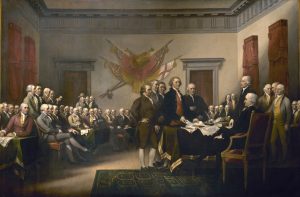 On July 5, the U.S. Court of Appeals for the DC Circuit, in Public Employees for Environmental Responsibility v. Hopper, Acting Director of the U.S. Bureau of Ocean Energy Management, reviewed the District Court’s dismissal of a lawsuit alleging that the Government’s approval of a Cape Cod offshore wind energy project violated several environmental statutes. The Court of Appeals held that the National Environmental Policy Act (NEPA) finding made by the primary permitting agency, the U.S. Bureau of Ocean Energy Management (Bureau), did not take a sufficiently “hard look” at the proffered geophysical evidence, and that an Endangered Species Act (ESA) “incidental take” determination must be set aside because the U.S. Fish and Wildlife Service should have considered the submissions of the plaintiffs. Otherwise, the Court of Appeals was satisfied with the project’s compliance with the other permitting and development requirements. The Court of Appeals notes that “[o]ffshore energy providers like Cape Wind must comply with a slew of federal statutes designed to protect the environment, promote public safety, and preserve historic and archeological resources on the outer continental shelf.”
On July 5, the U.S. Court of Appeals for the DC Circuit, in Public Employees for Environmental Responsibility v. Hopper, Acting Director of the U.S. Bureau of Ocean Energy Management, reviewed the District Court’s dismissal of a lawsuit alleging that the Government’s approval of a Cape Cod offshore wind energy project violated several environmental statutes. The Court of Appeals held that the National Environmental Policy Act (NEPA) finding made by the primary permitting agency, the U.S. Bureau of Ocean Energy Management (Bureau), did not take a sufficiently “hard look” at the proffered geophysical evidence, and that an Endangered Species Act (ESA) “incidental take” determination must be set aside because the U.S. Fish and Wildlife Service should have considered the submissions of the plaintiffs. Otherwise, the Court of Appeals was satisfied with the project’s compliance with the other permitting and development requirements. The Court of Appeals notes that “[o]ffshore energy providers like Cape Wind must comply with a slew of federal statutes designed to protect the environment, promote public safety, and preserve historic and archeological resources on the outer continental shelf.”
Controversial “Climate Change” Video Results in Significant FOIA Decision by DC Circuit
On July 5, the U.S. Court of Appeals for the District of Columbia Circuit issued an important ruling interpreting the reach of the federal Freedom of Information Act (FOIA) in the case of Competitive Enterprise Institute v. Office of Science and Technology Policy. The Office is located in the Executive Branch, and it has been engaged in a long-running dispute with the Competitive Enterprise Institute (CEI) with respect to a short, two-minute video released by the Director of the Office, John Holdren. In the instant action, the Court of Appeals reviewed the CEI’s attempts to obtain the records of the Director found in emails sent to or from the Director’s private, non-governmental email account.
the federal Freedom of Information Act (FOIA) in the case of Competitive Enterprise Institute v. Office of Science and Technology Policy. The Office is located in the Executive Branch, and it has been engaged in a long-running dispute with the Competitive Enterprise Institute (CEI) with respect to a short, two-minute video released by the Director of the Office, John Holdren. In the instant action, the Court of Appeals reviewed the CEI’s attempts to obtain the records of the Director found in emails sent to or from the Director’s private, non-governmental email account.
New Law Calls for Agency Transparency
My colleague Mark Elliott, in Open Wide: FOIA Reform Expands Public Access to U.S. Government Information, discusses the bipartisan Freedom of Information Improvement Act of 2016 (S. 337)  signed into law by President Obama’s on June 30. The bill’s most notably requirement is that the government operate under a “presumption of openness” and help protect the public from government secrecy. Its goal otherwise is to make it more difficult for agency officials to withhold government records sought under the Freedom of Information Act (aka FOIA).
signed into law by President Obama’s on June 30. The bill’s most notably requirement is that the government operate under a “presumption of openness” and help protect the public from government secrecy. Its goal otherwise is to make it more difficult for agency officials to withhold government records sought under the Freedom of Information Act (aka FOIA).
Photo: J. Albert Bowden II, Keep Calm and Use FOIA, Taken April 1, 2014 – Creative Commons
Princesses Everywhere Embrace Recent Decision, Private Land Owners Not So Much
This decision is reminiscent of a fairytale about a princess and her frog prince and the croaking chorus of the Frogs of Aristophane.  On June 30, the U.S. Court of Appeals for the Fifth Circuit issued a significant ruling involving critical habitat designations on private land. The case was decided on a 2 to 1 vote, with Judge Owen providing a strong dissent. The majority was at pains to state that “critical habitat designations do not transform private land into wildlife refuges.” Nevertheless, the extension of the Endangered Species Act (ESA) to this private land may conceivably have federal permitting consequences later if the future development of the land triggers Clean water Act considerations.
On June 30, the U.S. Court of Appeals for the Fifth Circuit issued a significant ruling involving critical habitat designations on private land. The case was decided on a 2 to 1 vote, with Judge Owen providing a strong dissent. The majority was at pains to state that “critical habitat designations do not transform private land into wildlife refuges.” Nevertheless, the extension of the Endangered Species Act (ESA) to this private land may conceivably have federal permitting consequences later if the future development of the land triggers Clean water Act considerations.
4th of July — What a Declaration
Volume One of the U.S. Code Annotated publishes the Organic Laws of the United States of America, and this collection  begins with the Declaration of Independence. On the 4th of July, 1776, the Declaration of Independence was agreed to, engrossed on paper, signed by John Hancock as president of the Continental Congress, and the Declaration was circulated and directed to be proclaimed in each of the United States. Today, the United States is the oldest constitutional democracy, and the form of government we enjoy is still vigorous, practical, argumentative, and the envy of the world. Self- governance has always been difficult, and there is no reason to think that the future will make any fewer demands on the citizens of our Great Country than it did in the past. Happy 4th of July weekend everyone!
begins with the Declaration of Independence. On the 4th of July, 1776, the Declaration of Independence was agreed to, engrossed on paper, signed by John Hancock as president of the Continental Congress, and the Declaration was circulated and directed to be proclaimed in each of the United States. Today, the United States is the oldest constitutional democracy, and the form of government we enjoy is still vigorous, practical, argumentative, and the envy of the world. Self- governance has always been difficult, and there is no reason to think that the future will make any fewer demands on the citizens of our Great Country than it did in the past. Happy 4th of July weekend everyone!
Photo: conservativemajority, Declaration of Independence by John Trumbull, Taken on April 26, 2010 – Creative commons
Two Federal Courts Issue Guidance on DOL’s “Persuader Rule”
Recent Department of Labor (DOL) rulemaking proceedings and compliance letters have been successfully challenged in the federal courts. These cases are important because the work of the DOL, in enforcing and interpreting the law, is of fundamental importance to both employers and employees and their counsel. A few days ago, the U.S. Court of Appeals for the DC Circuit, in Rhea Lana, Inc., et al., v. Department of Labor, held that a “DOL “warning letter” was a final agency action that could be reviewed by the federal courts, and the U.S. Supreme Court, in Encino Motorcars, LLC v. Navarro, held that a Fair Labor Standards Act interpretive rule was not entitled to Chevron deference. Now, the new “persuader rule” subjecting the advice that attorneys provide employers to new reporting requirements appears to be inconsistent with the basic statutory framework according to two new rulings by federal district courts.
DC Circuit Denies Petitions to Review Non-Export-Related Environmental Consequences of FERC Action
Two recently issued decisions are important because they clarify how the formidably complex legal structure affecting a growing American business—the export of liquefied natural gas (LNG) –will be interpreted by the one federal Court of Appeals that has singular expertise in interpreting such requirements. On June 28, the U.S. Court of Appeals for the DC Circuit denied two petitions to review National Environmental Policy Act (NEPA) environmental issues affecting two separate FERC LNG export terminal facilities; the two cases are Sierra Club and Galveston Baykeeper v. FERC ( pertaining to the Freeport, Texas terminal ) and Sierra Club v. FERC (regarding the Sabine Pass Terminal). These cases were argued by and decided by the same attorneys and panel of judges. The Court of Appeals found that the petitioners had demonstrated sufficient standing, but the basic flaw in their argument seems to have been that FERC’s role is fairly circumscribed by law, and the major complaint was that the export of LNG would inevitable reduce the supply of natural gas for domestic purposes, thus increasing reliance on cheaper sources of energy such as coal.
DC Court: EEOC Guidance Final Action Subject to Review in Federal Court
A recent decision by the U.S. Court of Appeals for the Fifth Circuit is a reminder to important federal agencies that they must take care to adhere to the requirements of the Administrative Procedure Act (APA) when they issue not only new rules, but also other regulatory documents as well, and that the federal courts can, in appropriate cases, step into a controversy at an early stage. On June 27, the Fifth Circuit ruled, in a 2 to 1 opinion, that a 2012 Equal Employment Opportunity Commission (EEOC) Enforcement Guidance, entitled “Enforcement Guidance on the Consideration of Arrest and Conviction Record in Employment Decisions Under Title VII of the Civil Rights Act of 1964” was a final action, and the lower court erred in dismissing a declaratory judgment action filed by the State of Texas. The case is State of Texas v. Equal Opportunity Commission.
Unclaimed accounts payable or payroll?
A very interesting unclaimed property memorandum opinion was recently issued by the U.S. District Court for the District of Delaware in Temple-Inland, Inc. v. Cook, et al. After the State of Delaware conducted an audit going back 22 years and assessed Temple-Inland a liability of $2,128,834.13, which was comprised of unclaimed accounts payable and payroll, Temple-Inland filed a complaint challenging that the State’s actions violate federal common law and several constitutional provisions, including substantive due process, the takings clause, and the ex post facto clause. The District Court considered the constitutional limits to Delaware’s enforcement of its unclaimed property laws. Upon review, the District Court concluded, in part, “[t]o put the matter gently, [the State] ha[s] engaged in a game of ‘gotcha’ that shocks the conscience.”
Saving P3 Projects in California
Today, my colleague Norman Carlin published an interesting piece discussing a pair of recent decision issued by the Fourth District Court of Appeal upholding a public-private partnership (P3) water project against two California Environmental Quality Act (CEQA) challenges. The two decisions are Delaware Tetra Technologies, Inc. v. County of San Bernardino, 247 Cal. App. 4th 352.(2016) and Center for Biological Diversity v. County of San Bernardino, 247 Cal. App. 4th 326 (2016). Norman’s alert is Saving Private Partnerships: Court Upholds P3 Project against CEQA Challenge under Save Tara.




